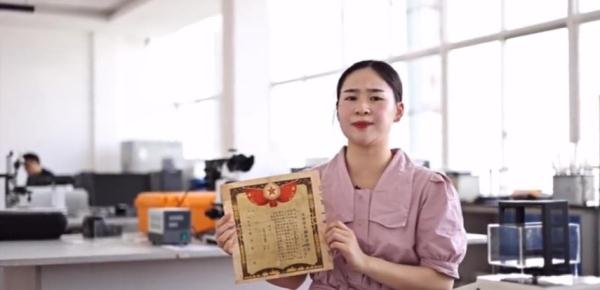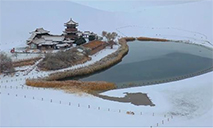University students in Ningbo city restore Korean War relics of Chinese martyrs
A conservation team for cultural relics consisting of students born in the 2000s and teachers from a university in Ningbo, east China’s Zhejiang province, recently successfully restored the relics of several Chinese martyrs who sacrificed their lives for their country during the Korean War, known in China as the War to Resist U.S. Aggression and Aid Korea (1950-1953).

Li Yueting, a member on the team, displays the certificate awarded posthumously to Chen Zhonggen. (Photo/gqviewpoint)
In late October, the team from the College of Humanities under the Ningbo University of Finance and Economics arrived at Hushan village in the city to check the conditions of the relics left behind by Wang Wencai, a martyr of the Chinese People’s Volunteers (CPV) during the Korean War, alongside with Sun Jiayi, who has founded a public welfare program that aims to collect information about the fallen martyrs.
According to the martyr’s nephew Wang Yongyi, 65, his uncle was among those who moved into the territory of the Korean Peninsula in 1950, having gone on to sacrifice himself in November of the same year. After the senior citizen watched the Chinese blockbuster “The Battle at Lake Changjin,” a film that tells the story of CPV soldiers who fought bravely in freezing temperatures during a key campaign at Lake Changjin, or Chosin Reservoir, he wondered whether his uncle had lost his own life during the same campaign. His conjecture was later confirmed with evidence provided by Sun Jiayi, who has rich experience in collecting information about martyrs.
Unfortunately, a broken horizontal board inscribed with illegible Chinese characters that read “revolutionary pioneer” and an out-of-shape canteen were the martyr’s only remains found at Wang Yongyi’s home.
To repair the remains, team members decided to calculate the size of the missing section of the horizontal board and redesigned the indistinct characters using computer simulation techniques. They went on to find a wood material similar to the board and mixed red paint that was the same as that previously used for the original board.

The certificate awarded posthumously to Chen Zhonggen before and after restoration. (Photo/gqviewpoint)
“We restored the martyr’s relics by following the principle of keeping their original appearances unchanged,” said Jiang Wenqian, a member of the team.
The team also restored the relics remaining from Chen Zhonggen, a CPV martyr who lost his life in 1951. According to Chen Hezhen, the daughter of the martyr, her father only left behind a damaged certificate of heroism and a letter. Whenever the characters on the certificate faded and became illegible, she would trace them out again. She also sellotaped the certificate several times.
Four cultural relic restorers on the team used degumming agents to remove sellotape while avoiding further damage to the certificate. It took them over 10 days to complete the restoration process for the single certificate.
“Now we have the opportunity to directly ‘communicate’ with martyrs and feel their pure love for our motherland through the campaign,” said Wang Yutong, another member of the team, noting that their impression of the CPV was primarily based on indirect means in the past.
The team came up with the idea of restoring the relics left behind by the martyrs, such as original documents, certificates, and photos, after they found that most of the remains were damaged to different degrees during a visit to families of the martyrs.
Repairing damaged documents requires going through over 10 procedures and it takes half a month or even several months to restore just one document. The process for restoring damaged documents demands skill, patience and a comprehensive understanding of the documents’ background and source.
Starting from this summer vacation, the team has restored seven original documents, letters and photos of martyrs and has since sent them back to the martyrs’ families. The team has also received eight more items among martyrs’ belongings from provinces including Liaoning and Shandong for further restoration.
“We will continue to shoulder our responsibility in repairing the relics of martyrs and sharing their stories with more people,” said Wang Yiqun, who serves as the head of the team.
Photos
Related Stories
- Chinese soldiers killed in Korean War laid to rest
- Remains of 109 Chinese soldiers killed in Korean War return
- S. Korea returns 109 remains of Chinese soldiers killed in Korean War
- 109 remains of Chinese soldiers killed in Korean War casketed in S. Korea
- Remains of more Chinese martyrs in Korean War to be returned
Copyright © 2021 People's Daily Online. All Rights Reserved.










